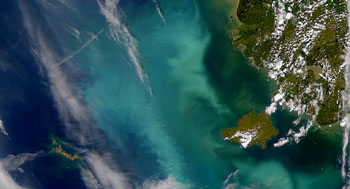| |
Final Thoughts
Though not enough information is available to draw a strong conclusion,
all of these anomalies appear to stem in part from a lack of nutrients and warmer temperatures
throughout
the surface of the Bering Sea. The NOAA report (Stabeno et al. 1998) further suggests El Niño could be
blamed for the depletion of nutrients and rise in temperatures in 1997, but not in 1998. Two years ago
across the eastern half of the Pacific, the winds normally blowing from east to west subsided in classic
El
Nino fashion. These winds keep the warm water in the western Pacific away from the east, and when they
stopped, much of the warm western water drifted to the coasts of Northern America. The warm waters were
nutrient poor and did not allow the colder, nutrient-rich waters along the coast to rise to the ocean’s
surface. Many plants and animals suffered all along the Pacific coast of North and South America.
|
|

|

In 1998, the El Nino subsided, and colder waters were allowed to come to the top again. But in the
Alaskan waters, the previous year’s pattern was repeated, stated the NOAA report. The diatoms exhausted
the Bering Sea shelf of the nutrients by late spring. Over the summer, surface waters warmed, skies
cleared, and few nutrients came in from the edge of the continental shelf or from underlying waters.
These changes allowed the coccolithophores to gain a foothold and grow in mass.
Though no one in the scientific community knows why these conditions are persisting, several theories
have been proposed. Phyllis Stabeno, a physical oceanographer at NOAA in Seattle, said the lack of
nutrients may be a result of recent changes in the slope current, which runs northward along the edge of
the continental shelf.
Stabeno said, "The current carries nutrients past the Bering Sea. For these nutrients to get onto the
shelf, there need to be cross-shelf flows to move the water from the slope and onto the shelf." These
cross-shelf flows are formed when eddies and other imperfections in the current redirect some of its
water towards the continental shelf.
She explained that over the past several years, the speed of the slope current has more than doubled.
This may have caused the current to become a more effective carrier of nutrients. And if nutrients are
no longer being thrown onto the shelf from the current, scientists could have the reason for the
anomalies in the Bering Sea.
Global warming could be the reason some of these normally balanced mechanisms in the Bering Sea have gone
haywire. This would certainly explain the warmer temperatures on the Bering Sea’s surface. As for the
slope current, an increased melting of the Arctic ice caps could theoretically speed up the current.
The only way for this theory to be proven is if there is a prolonged and increasingly severe change in
the Bering Sea. For now, it looks as if there will be another large coccolithophore bloom again this
year. Stabeno said she has seen the latest aerial photographs of the Bering Sea, and there are
coccolithophores poking out along the edges of the partially thawed ice.
Works Cited
- P. J. Stabeno, N. Mantua, J.E. Overland, S. A. Macklin, and G. Weller, 1998: Draft Report of the
FOCI International Workshop on Recent Conditions in the Bering Sea, Climate and Upper Ocean Physics
pp. 9-14.
- J. M. Napp, K. O. Coyle. T. E. Whitledge, D. E. Varela, M. V. Flint, N. Shiga, 1998: Draft Report of
the FOCI International Workshop on Recent Conditions in the Bering Sea, Nutrients and Lower Trophic
Level Response, pp. 15-21.
- R. D. Brodeur, G. H. Kruse, P. A. Livingston, G. Walters, J. Ianelli, G. L. Swartzman, M.
Stepanenko, and T. Wyllie-Echeverria, 1998: Draft Report of the FOCI International Workshop on
Recent Conditions in the Bering Sea, pp. 22-26
- NOAA, 1998: Draft Report of the FOCI International Workshop on Recent Conditions in the Bering Sea
(S.A. Macklin ed.), Introduction, pp. 2-5.
 Big Trouble in the Bering Big Trouble in the Bering
|
This satellite image of the Bering
Sea was aquired on July 20, 1998. The mottled water just off the coast of Alaska remains relatively free
of coccolithophores—instead it is colored brown by silt. (SeaWiFS Image courtesy Norman Kuring, SeaWiFS
project)
|

